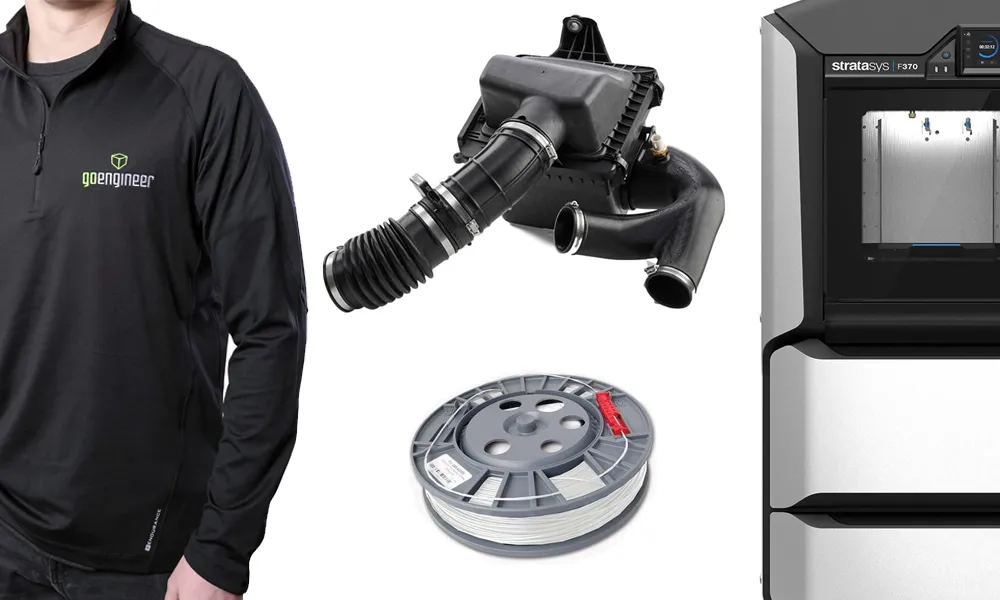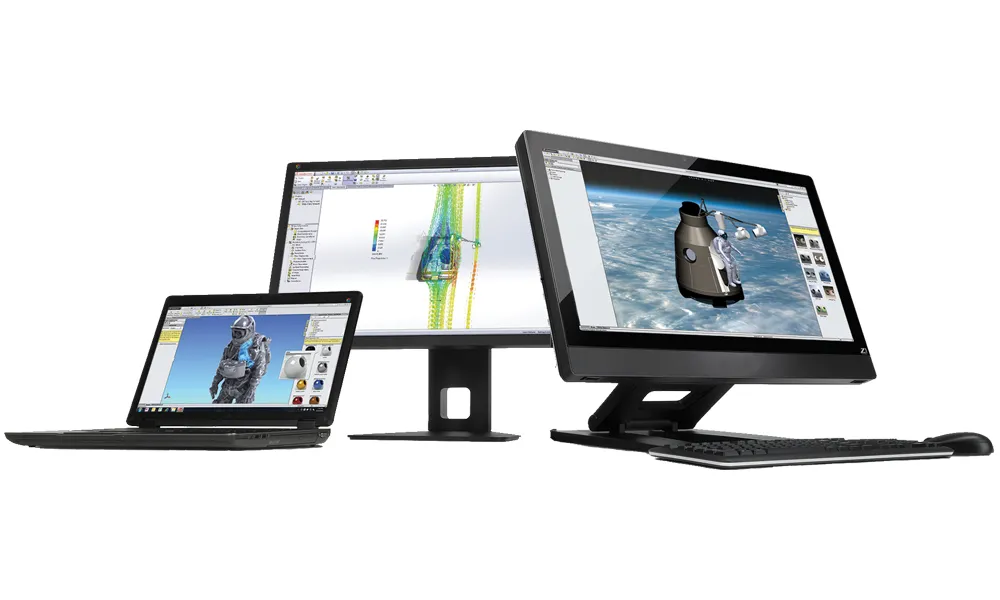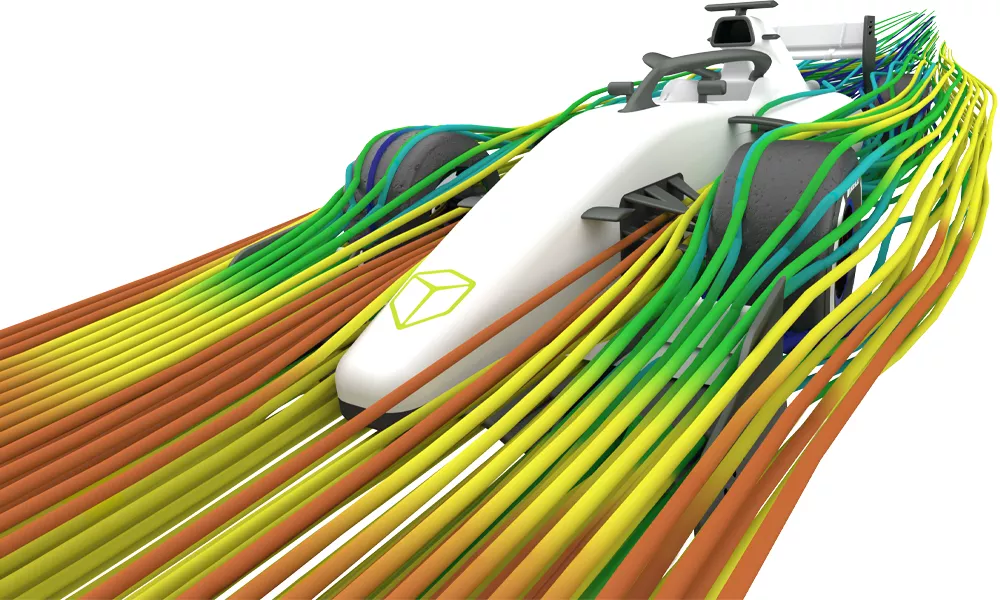SOLIDWORKS Flow Simulation
Computational Fluid Dynamics (CFD) Software
What is Computational Fluid Dynamics (CFD) Software?
Computational Fluid Dynamics or CFD is a technique that deals with the solution of fluid flow fields through numerical analysis. SOLIDWORKS Flow Simulation is a CFD software designed for the everyday SOLIDWORKS user and analyst. It provides dynamic feedback on the fluid flow and thermal performance of their products. With parametric optimization capabilities, users can automate the design and analysis process to discover the best iteration of their design within the familiar SOLIDWORKS CAD environment.
 Software.png?format=webp)
Simulate Fluid and Gas Flow
Flow Simulation enables users to simulate a wide variety of liquids and gases for different engineering scenarios. A few common applications are flow through manifolds, heat exchangers, electronics cooling and aerodynamics. Check out the videos to see some examples of fluid flow and heat transfer situations in SOLIDWORKS Flow Simulation and CFD software.
“…exceptionally knowledgeable and professional in helping customers as well as demonstrating the full potential of the software and background information.”
– Haojun Fu

Tools
SOLIDWORKS Flow Simulation CFD analysis tools to ensure quick and accurate results of your 3D CAD designs.
FEA Integration
System-level design requires optimizing fluid behavior and material strength. Because SOLIDWORKS incorporates CFD analysis and FEA, designers can incorporate both with the FEA transfer from SOLIDWORKS Flow Simulation. This allows engineers to use the resulting force and heat transfer effects from their CFD analysis as the load inputs in their FEA analysis to fully understand the structural behavior based on fluid behavior.
Rotating System Analysis
Coming up with optimal designs for systems with fan blades or impellers is impossible without accurate results. SOLIDWORKS Flow Simulation provides users with tools that allow for rotating regions and sliding mesh methods to accurately simulate the behavior of these types of systems based on geometry, angular velocity, and transient behavior of the fluid.
External Flow Analysis
External analysis is used when we need to understand the fluid behavior around our model based on the environmental conditions. Wind turbines, airplanes, ships, heat sinks, and automobiles would all be studied using external flow analysis. In external studies, the computational domain acts as our virtual wind tunnel with boundary conditions, heat sources, and transient behavior all applied through the user-friendly setup wizard.
Internal Flow Analysis
PCB enclosures, valves, pumps, and manifolds are all examples of internal analysis studies. Because SOLIDWORKS Flow Simulation functions inside of SOLIDWORKS CFD software, setting up computational domains, boundary conditions, and heat sources can be done in minutes. The results of your analysis can be applied directly to your design allowing you to test more iterations in less time.
Free Surface Dynamics
Free surface is a condition with a freely moving surface between two fluids that don’t mix, such as air and water. Using the Volume of Fluids approach, we can accurately simulate transient conditions such as tank sloshing or any open bath fluid behavior. Not only can these tests give us a better understanding of what the fluid is doing in the system, but we can also gather useful quantitative results such as force or pressure on internal walls.
Electronics Cooling Module
An add-on for SOLIDWORKS Flow Simulation, the Electronics Cooling Module (ECM) provides additional materials and material models that are specific to circuit board and PCB enclosure analysis. The Two-Resistor component model is a JEDEC approved method for simulating chip temperatures such as BGA, QFP, QFN, and SOP. The PCB-generator understands layer properties to provide accurate orthotropic thermal behavior. Joule heating capabilities mean designers can apply current as the input to estimate heat generation.
Particle Study
For certain applications, the fluid in a design might contain solid or liquid particles. The behavior of these particles and the fluid that interacts with them is critical to the function and efficacy of your system. With particle studies in SOLIDWORKS Flow Simulation, we can analyze the particle behavior and see results for erosion and accretion of the system and the particle based on material properties, mass flow rate, and other physical characteristics of the system design.
Parametric Optimization
SOLIDWORKS Flow Simulation is a robust and complete CFD analysis tool. But, its integration into SOLIDWORKS CAD means it’s also a powerful design tool. This integration also opens the doors for optimizing your parameter-driven design based on the iterative results of the CFD studies and user-defined goals for the results.
HVAC Module
Accurately understanding HVAC systems is a complicated task. That’s why SOLIDWORKS created the HVAC add-on module for SOLIDWORKS Flow Simulation. This tool provides additional capabilities such as advanced radiation which modifies the way radiation between bodies, including semi-transparent materials such as glass, is calculated to provide higher fidelity of result information. The tracer study function allows the simulation of pollutants in a volume and shows how and where that pollutant will disperse in an environment.
Frequently Asked Questions
Features
SOLIDWORKS Integration
Create flow analysis projects directly on your models without importing or exporting geometry. The Flow Simulation module is fully embedded within SOLIDWORKS and utilizes the CAD User Interface to set up the analysis.
Fluid Volume Recognition
The CFD software automatically recognizes the fluid volume in your design based on the type of analysis. Users will no longer have to manually extract and define the fluid regions for their analyses, which significantly simplifies the setup process. Identify and fix leaks in the model using the check geometry and leak detection tools.
Guided Analysis Setup
Utilize the Analysis Wizard to set up multiple CFD scenarios through a guided process. Build analysis templates with the appropriate input criteria and avoid missing parameters that could be critical to the accuracy of your analysis.
Solution-Based Meshing Techniques
Take advantage of the dynamic meshing technique that auto-refines the mesh in regions of high-fluid activity. Utilizing the powerful grid-based cartesian meshing algorithm, the CFD software can adaptively change the mesh during the solution process to yield accurate results.
Analysis Automation
Investigate multiple design variations using the optimization tools in Flow Simulation. The parametric study functionality takes design variables and simulation criteria as inputs to automatically determine the best design for a variety of flow and thermal scenarios.
Multi-Physics
Simulate fluid flow and heat transfer simultaneously to tackle a variety of challenges involving conduction, convection, and radiation. Determine the effect of fluid flow on the thermal performance of your designs.
"...friendly attitude and talked me through the problems perfectly. Everyone I've dealt with at GoEngineer when needing support has always been friendly and courteous. Two thumbs up indeed!!”
- Matthew Grace

Matrix
Simulation
MODULE
COOLING MODULE
Design Data Reuse
Multi-Parameter Optimization
SOLIDWORKS Flow Simulation Capabilities
Material Database
Internal - External
2D - 3D
Heat Conduction in Solids
Gravity
Rotation
Free Surface
Symmetric
Gases, Liquid, and Steam
Boundary Layer Description
Mixing Flows
Non Newtonian Fluids
Flow, Thermal, and Wall Conditions
Porous Components
Visualization
Results Customization
Communication & Reporting
Two-Phase (Fluid + Particles) Flows
Noise Prediction (Steady State and Transient)
Thermoelectric Coolers (TECs),
Thermal Joint
Contact Resistance
- Advanced radiation capabilities, with the added Discrete Ordinates method, span the radiation spectrum from 100nm to 100,000nm and allow partially absorptive materials, like glass, into the radiative calculation.
- Track a fluid contaminant through the fluid flow. Predict diffusion, condensation, or vaporization.
- Additional result types estimate thermal comfort against established statistics. Uses the PMV/PPD method, and outputs other results such as air quality, effective draft temperature, and others.
- Use Joule Heating through electro-conductive solids to determine temperature distribution due to current passing through or voltage drops across a system, and a larger material database including semiconductors, polymers, ceramics and interface materials.
- Simplify board layouts with pre-defined components that generate heat, apply accurate resistance or force convection without requiring a detailed model. Component simplification options are: PCB Generators, Two-Resistor Components, and Heat Pipes. Adds a larger database of Fans, Thermoelectric Coolers, and Two-resistor components from different manufacturers.
SOLIDWORKS Services:
Utilize GoEngineer’s Award Winning Support & Training for SOLIDWORKS
Award Winning Technical Support
GoEngineer's extensive SOLIDWORKS technical knowledge and world class support can help you succeed with SOLIDWORKS. Our award-winning team is ready to help you with any task you may have. Using state-of-art remote assistant technology software allows our team to solve most issues within one session. Reach out and see why GoEngineer is the #1 reseller of SOLIDWORKS and Stratasys systems in the world!
- 125+Certified Technical Specialists
- Email, Phone and Chat Support Available
- 98% Exceptional Customer Service Rating
PROFESSIONAL SOLIDWORKS TRAINING
GoEngineer offers online and classroom professional SOLIDWORKS training for organizations and individuals. All our instructors are SOLIDWORKS certified and teach thousands of students each year world wide. The curriculum is very diverse with numerous certified SOLIDWORKS courses to choose from. Each student will receive a Course Completion Certificate and preparation materials for SOLIDWORKS certification.
- Increase Your Earning Potential
- Led by Certified SOLIDWORKS Instructors
- Smaller Classes with Focused Attention
Additional Resources
Take Advantage of GoEngineer’s Extensive Knowledge Base and Resources

Find a Solution
Our robust Knowledge Base contains over 12,000 resources to help answer your product design questions. From basic CAD questions to in-depth guides and tutorials, find your solution here. Find a Solution

PROFESSIONAL TRAINING
Improve your skills with professional training and certifications in SOLIDWORKS, CAM, 3D Printing, and 3D Scanning offered four ways: self-paced, online, on-site, or in-classroom. Certified Training Courses

BLOG
#1 Technical Resource Worldwide - Right at your fingertips. Search or browse through hundreds of SOLIDWORKS tips & tricks, additive manufacturing product developments, announcements, how-to guides, and tutorials. Blog

YouTube Channel
Our YouTube channel hosts hundreds of educational tutorials, product demonstrations, recorded webinars, and best practices for all of our products and services. GoEngineer's YouTube Channel

ONLINE STORE
Order 3D printing materials and consumables, enroll in SOLIDWORKS training classes, and buy official GoEngineer gear directly from our online store. Online Store

WEBINARS
Our engineering webinars are hosted by some of the top experts in the industry. They are always recorded, always free, and always offer a live Q&A. WEBINARS
3D Printing Services
Need to 3D print a part? Our Additive Manufacturing experts will 3D print your part and deliver it to you using the latest technology on one of our professional FDM, PolyJet and SL 3D printers. 3D Printing Services
